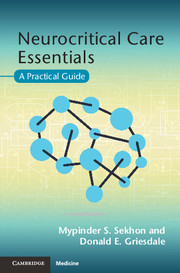Book contents
- Frontmatter
- Contents
- List of Contributors
- Foreword 1
- Foreword 2
- Acknowledgments
- List of Abbreviations
- Section 1 Fundamentals of neurocritical care
- Section 2 Neurosurgical critical care
- Chapter 6 Severe traumatic brain injury
- Chapter 7 Subarachnoid hemorrhage
- Chapter 8 Intracranial hemorrhage
- Chapter 9 Spinal cord injury
- Chapter 10 Hydrocephalus
- Section 3 Neurological critical care
- Index
- References
Chapter 10 - Hydrocephalus
Published online by Cambridge University Press: 05 April 2015
- Frontmatter
- Contents
- List of Contributors
- Foreword 1
- Foreword 2
- Acknowledgments
- List of Abbreviations
- Section 1 Fundamentals of neurocritical care
- Section 2 Neurosurgical critical care
- Chapter 6 Severe traumatic brain injury
- Chapter 7 Subarachnoid hemorrhage
- Chapter 8 Intracranial hemorrhage
- Chapter 9 Spinal cord injury
- Chapter 10 Hydrocephalus
- Section 3 Neurological critical care
- Index
- References
Summary
Definition: A disturbance of cerebral spinal fluid formation, flow or absorption resulting in enlarged cerebral spinal fluid compartment within the central nervous system.
Communicating hydrocephalus: Hydrocephalus with full communication between the ventricular system and the subarachnoid space. It is usually caused by ineffective CSF absorption or excess CSF production.
Non-communicating hydrocephalus: Hydrocephalus results from an obstruction of CSF flow within the path of the ventricular system or its outlets.
Normal pressure hydrocephalus: Hydrocephalus occurring in predominantly elderly patients who exhibit normal intracranial pressure, in spite of increased CSF compartment size.
- Type
- Chapter
- Information
- Neurocritical Care EssentialsA Practical Guide, pp. 101 - 108Publisher: Cambridge University PressPrint publication year: 2015

